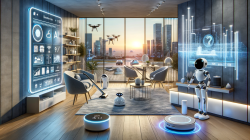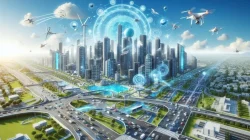The journey of robotics is a fascinating tale of technological evolution, from its inception in industrial settings to its growing presence in homes, streets, and even personal spaces. Once confined to the walls of manufacturing plants, robots have gradually expanded their reach into everyday life. From automated assembly lines to robotic vacuum cleaners, delivery drones, and even personal assistants, robotics is increasingly becoming a part of the fabric of modern society.
In this article, we will explore the historical milestones in robotics, discuss how robots have transformed industries, and examine how robotics is now making its way into homes, providing convenience and changing the way we interact with technology on a daily basis.
1. The Origins of Robotics
The term “robot” comes from the Czech word robota, meaning forced labor, first used in the 1920 play R.U.R. (Rossum’s Universal Robots) by Karel Čapek. However, while robots as we know them today didn’t exist at the time, the idea of automating labor has been around for centuries. Early machines like mechanical clocks and automated figures in Europe demonstrated the concept of motion without human intervention.
The first significant leap towards robotics came with the industrial revolution in the late 18th and early 19th centuries. Early machines like the Jacquard loom, which used punch cards to control the pattern of weaving, laid the groundwork for more advanced automation technologies. But the real birth of robotics in the modern sense began in the mid-20th century.
2. The Dawn of Industrial Robotics
The 1950s and 1960s marked the birth of industrial robotics. In 1956, George Devol and Joseph Engelberger co-founded Unimation, which developed the first programmable robot, Unimate. Unimate was initially designed to lift and transport parts around a factory floor, drastically reducing the need for human workers in dangerous and repetitive tasks.
In 1961, the first industrial robot, Unimate, was installed at General Motors’ production line in New Jersey, marking a pivotal moment in automation. These early robots were large, heavy, and relatively simple by today’s standards. They were confined to specific tasks in controlled environments, such as welding and painting, on assembly lines in automobile factories.
The success of industrial robots led to the rapid expansion of robotics in factories, where they took on roles such as packaging, material handling, and assembly. By the 1980s, robots were being used in various industries beyond automotive manufacturing, including electronics, food production, and pharmaceuticals.
3. The Emergence of Service Robots
As technology advanced, so did the potential applications of robotics. By the 1990s, robots were beginning to move beyond industrial settings into more diverse environments. A key moment in this evolution was the development of autonomous mobile robots (AMRs). These robots were designed to navigate more flexible environments, such as warehouses and hospitals, without the need for fixed tracks or rails.
A notable development came in 1997 when iRobot released its first robotic vacuum cleaner, the Roomba. This small, autonomous robot was designed to clean floors in homes and offices, and it became an instant success. The Roomba’s ability to navigate around furniture, detect dirt, and operate autonomously made it a game-changer in the consumer robotics market.
Service robots also began to gain traction in other areas. For example, robots in healthcare were used for surgeries, like the da Vinci Surgical System, which allowed doctors to perform minimally invasive procedures with greater precision. Similarly, robots were introduced in hospitality, where they assisted in tasks like delivering room service or greeting guests at hotels.
4. Robotics and the Advent of Autonomous Vehicles
One of the most significant advancements in robotics has been in the development of autonomous vehicles. Starting with self-driving cars, the ambition to create machines capable of navigating and operating independently has been a major area of focus for tech companies, automakers, and research institutions.
In the early 2000s, self-driving cars began to emerge, with research projects led by institutions like Stanford and the Massachusetts Institute of Technology (MIT). The DARPA Grand Challenge, initiated by the U.S. Department of Defense in 2004, accelerated the development of autonomous vehicles, providing a platform for testing and pushing the boundaries of robotic driving technology.
By the 2010s, tech giants such as Google (now Waymo) and Tesla began testing their own self-driving systems, integrating AI, machine learning, and sophisticated sensors such as LIDAR to create vehicles capable of navigating roads without human intervention. These advancements have not only shaped the future of transportation but also influenced the broader landscape of robotics, pushing forward the concept of intelligent machines that can make decisions, adapt to environments, and perform tasks autonomously.
5. Consumer Robots: Into the Home
The last decade has seen an explosion of consumer robots that go far beyond just vacuuming the floors. Today, robots are finding their way into our kitchens, living rooms, and even our front doors. Let’s explore some of the key advancements in consumer robotics.
Robotic Assistants
One of the most recognizable developments in consumer robotics is the rise of virtual assistants powered by AI, such as Amazon’s Alexa, Google Assistant, and Apple’s Siri. These assistants, while not physical robots, represent a significant step toward more integrated, intelligent systems that can respond to voice commands and automate tasks like setting reminders, controlling smart home devices, or ordering groceries.
While virtual assistants remain non-physical, they are often paired with actual robots, such as robotic vacuum cleaners, home security cameras, and smart appliances, to create a fully automated, interconnected home ecosystem.
Delivery Robots
The rise of e-commerce and online shopping has also spurred innovation in the field of delivery robots. Autonomous delivery vehicles, including drones and ground-based robots, have begun to play a role in last-mile deliveries. Companies like Amazon, Starship Technologies, and Nuro are testing autonomous robots to deliver groceries, packages, and food to customers’ doorsteps.
These robots use a variety of technologies, including AI, GPS, and machine learning, to navigate streets and sidewalks safely. In some cities, small ground robots and drones are already making deliveries, dramatically reducing delivery times and costs while also helping reduce the carbon footprint of traditional delivery methods.
Robotic Healthcare Devices
Another area where robots have made their way into homes is healthcare. From wearable robots to assist with physical therapy to robotic exoskeletons that help people with mobility impairments, the medical field has embraced robotics to improve the quality of life for patients. Additionally, telepresence robots, which allow healthcare professionals to remotely interact with patients, are helping bridge the gap in rural and underserved areas.
Entertainment and Companionship
Robots are also beginning to enter the entertainment and companionship space. Social robots, such as SoftBank’s Pepper, are designed to interact with people, provide companionship, and even perform basic tasks like answering questions or providing entertainment. These robots are being used in various settings, from homes to public spaces, and are expected to play a role in reducing loneliness and improving mental health in the future.
6. The Future of Robotics
As robotics continues to evolve, we can expect even more innovations that will further integrate robots into our daily lives. Some key trends to watch for include:
Smarter Robots with AI
The integration of AI will make robots smarter and more capable of performing complex tasks. Machine learning algorithms will allow robots to adapt to different environments and perform tasks that were once thought to be too complicated for machines.
Collaborative Robots (Cobots)
Cobots are designed to work alongside humans, assisting them in various tasks. These robots will likely play a bigger role in workplaces and homes in the future, collaborating with humans in manufacturing, healthcare, and even personal tasks like cooking and cleaning.
Personal Robots for the Home
As robots become more affordable and versatile, they will likely become a regular feature in households. These robots could assist with everything from cleaning and cooking to caring for the elderly and children. The rise of personal robots may also open up new forms of entertainment, as robots become more interactive and capable of engaging in more complex tasks.







